Watch this on Rumble: https://rumble.com/v6bnxks-smart-meters.html
A smart meter takes automatic readings of your commercial or residential electricity usage and communicates it wirelessly with your energy supplier. A smart meter is an electronic device that records information-such as consumption of electric energy, voltage levels, current, and power factor-and communicates the information to the consumer and electricity suppliers. Such an advanced metering infrastructure differs from automatic meter reading in that it enables two-way communication between the meter and the supplier.
The term smart meter often refers to an electricity meter, but it also may mean a device measuring natural gas, water or district heating consumption. More generally, a smart meter is an electronic device that records information such as consumption of electric energy, voltage levels, current, and power factor. Smart meters communicate the information to the consumer for greater clarity of consumption behavior, and electricity suppliers for system monitoring and customer billing. Smart meters typically record energy near real-time, and report regularly, in short intervals throughout the day. Smart meters enable two-way communication between the meter and the central system. Smart meters may be part of a smart grid, but do not themselves constitute a smart grid.
Such an advanced metering infrastructure (AMI) differs from automatic meter reading (AMR) in that it enables two-way communication between the meter and the supplier. Communications from the meter to the network may be wireless, or via fixed wired connections such as power line carrier (PLC). Wireless communication options in common use include cellular communications, Wi-Fi (readily available), wireless ad hoc networks over Wi-Fi, wireless mesh networks, low power long-range wireless (LoRa), Wize (high radio penetration rate, open, using the frequency 169 MHz) Zigbee (low power, low data rate wireless), and Wi-SUN (Smart Utility Networks).
Similar meters, usually referred to as interval or time-of-use meters, have existed for years, but smart meters usually involve real-time or near real-time sensors, power outage notification, and power quality monitoring. These additional features are more than simple automated meter reading (AMR). They are similar in many respects to Advanced Metering Infrastructure (AMI) meters. Interval and time-of-use meters historically have been installed to measure commercial and industrial customers, but may not have automatic reading. Research by the UK consumer group Which?, showed that as many as one in three confuse smart meters with energy monitors, also known as in-home display monitors.
Since the inception of electricity deregulation and market-driven pricing throughout the world, utilities have been looking for a means to match consumption with generation. Non-smart electrical and gas meters only measure total consumption, providing no information of when the energy was consumed. Smart meters provide a way of measuring electricity consumption in near real-time. This allows utility companies to charge different prices for consumption according to the time of day and the season. It also facilitates more accurate cash-flow models for utilities. Since smart meters can be read remotely, labor costs are reduced for utilities.
Smart metering offers potential benefits to customers. These include, a) an end to estimated bills, which are a major source of complaints for many customers b) a tool to help consumers better manage their energy purchases—smart meters with a display outside their homes could provide up-to-date information on gas and electricity consumption and in doing so help people to manage their energy use and reduce their energy bills. With regards to consumption reduction, this is critical for understanding the benefits of smart meters because the relatively small percentage benefits in terms of savings are multiplied by millions of users. Smart meters for water consumption can also provide detailed and timely information about customer water use and early notification of possible water leaks in their premises. Electricity pricing usually peaks at certain predictable times of the day and the season. In particular, if generation is constrained, prices can rise if power from other jurisdictions or more costly generation is brought online. Proponents assert that billing customers at a higher rate for peak times encourages consumers to adjust their consumption habits to be more responsive to market prices and assert further, that regulatory and market design agencies hope these “price signals” could delay the construction of additional generation or at least the purchase of energy from higher-priced sources, thereby controlling the steady and rapid increase of electricity prices.[citation needed]
An academic study based on existing trials showed that homeowners’ electricity consumption on average is reduced by approximately 3-5% when provided with real-time feedback. Another advantage of smart meters that benefits both customers and the utility is the monitoring capability they provide for the whole electrical system. As part of an AMI, utilities can use the real-time data from smart meters measurements related to current, voltage, and power factor to detect system disruptions more quickly, allowing immediate corrective action to minimize customer impact such as blackouts. Smart meters also help utilities understand the power grid needs with more granularity than legacy meters. This greater understanding facilitates system planning to meet customer energy needs while reducing the likelihood of additional infrastructure investments, which eliminates unnecessary spending or energy cost increases.
Though the task of meeting national electricity demand with accurate supply is becoming ever more challenging as intermittent renewable generation sources make up a greater proportion of the energy mix, the real-time data provided by smart meters allow grid operators to integrate renewable energy onto the grid in order to balance the networks. As a result, smart meters are considered an essential technology to the decarbonisation of the energy system.
A smart meter sends out blasts of up to 60,000 micro-watts per square meter of Radio Frequency (RF) Radiation (which is 60 times the U.S. safety limit) every 30 to 45 seconds, depending on how the specific power company has it set up. They also manipulate the AC current causing highly toxic “electric smog” (a.k.a. Dirty Electricity) on each electrical circuit the smart meter connects to.
Smart Meters are dangerous because they expose the occupants of the home or office to highly toxic amounts of RF Radiation and Dirty Electricity. And there are literally hundreds of independent peer reviewed scientific studies linking these “non-ionizing” forms of radiation to things like sleep disorders, tinnitus, cancer, exasperated diabetes, crib death, DNA damage (especially in infants and fetuses) and male infertility.
Some power companies around the United States have smart meter opt out programs. If you pay an extra fee every month, they will replace your smart meter with an analog meter that does not emit any RF Radiation. The fee is not typically very expensive. This is by far the best and safest option if you get your power from one of the power companies that will do this. Some people buy their own analog meter and have someone replace their smart meter. I show where you can get an analog meter here.
Exposure to smart meters EMF radiation has been reported to cause many strange and unknown health problems. Many of the illnesses caused by EMF radiation have no name. People who are affected begin to lose interest in life, they have lost their zest, enthusiasm and joy. They experience anxiety and depression, not knowing the cause of the symptoms.
Users of smart meters have complained of overcharging and irregularities reported from utility usage. Some reported skyrocketing bills after installation of smart meter, despite using the same amount of electricity prior to smart meter installation.
There are many disadvantages of having a smart meter installed at your home, and this article focuses on the health side effects of this new technology. Utility companies claim that smart meters are safe, but studies are showing that the meters expose users to high frequency of electromagnetic fields (EMF) radiation that are known to alter human biological functioning.
The World Health Organization (WHO) classifies wireless radiation as a 2B carcinogen, based on studies linking cell phone radiation to brain tumors.
The BioInitiative report, updated in 2012 contains nearly 2000 papers reviewed by 29 international scientists from over 20 countries on the health and environmental effects of electromagnetic fields.
Although the majority of people feel nothing when exposed to EMF radiation, proteins within their cells are being permanently altered and may cause symptoms later in life. The harmful effects are cumulative and can take between 5 and 10 years of exposure to evoke a life-threatening illness.
Some of the reported symptoms of exposure to smart meters EMF radiation include, but not limited to:
- Sleep problems
- Stress, agitation, anxiety, irritability
- Headaches
- Ringing in the ears
- Concentration and memory problems
- Fatigue, muscle and physical weakness
- Heart palpitations and chest pain
- Arthritis and other bodily pains
- Respiratory problems, sinus, asthma
- Endocrine disorders
- Seizures
Individuals who are already suffering these symptoms before installation of smart meters may find that with time, the symptoms will intensify after installation of the meters.
Many modern chronic illnesses are caused by, or influenced by long-term exposure to sources of EMF radiation such as cell phones, wifi routers, cordless phone base stations, bluetooth devices, baby monitors and other wireless devices that are used every day by modern civilization. However, smart meters are by far, the worst offenders in this list because the radiation is so persistent and powerful.
Utility companies want you to believe that the smart meters only broadcast information once a day or only once every 4 hours. This is not true! They actually broadcast intense levels of radiation several times per minute—non-stop and two ways—up to 190,000 times a day!
Sensitivity to EMF radiation differs among individuals due to the composition of minerals, density of minerals, electrolytes in the body, and even the body size. The amount of heavy metals in the body serve as “antenna” that responds to the radiation.
Dr. Jack Kruse. He suggests that battery-powered smart meters may contribute to the devastating spread of wildfires. Specifically, Dr. Kruse asks whether, in wildfires like those that ravaged Palisades, CA, some of the 12,000+ destroyed structures might have been compromised by smart meters equipped with lithium-ion batteries.
Lithium-ion batteries are efficient but highly sensitive to heat and physical damage. They’ve been implicated in fires involving e-scooters, laptops, phones, and even electric vehicles. The concern Dr. Kruse raises is whether the relatively small batteries in some smart meters could enter a state of thermal runaway—where the battery overheats, ignites, and spreads fire.
- Battery Size Matters: While most smart meter backup batteries are smaller than those in consumer electronics, the risk of thermal runaway still exists in extreme heat conditions.
- Wildfire Proximity: In a wildfire scenario, intense radiant heat from neighboring fires could cause the battery to overheat, potentially igniting the meter and surrounding materials.
- Electrical Sparks and Arcing: Beyond the battery, smart meters themselves could contribute to fires if damaged during installation or by external factors, creating electrical arcs or faults.
The 12,000+ structures destroyed in the Palisades and surrounding wildfires leave us with critical questions:
- How many of these homes had smart meters equipped with lithium-ion batteries?
- Did these batteries contribute to the fires or worsen the destruction?
While the official narrative often points to embers, wind, and vegetation as the primary culprits in wildfire destruction, we must also consider whether modern technologies, like smart meters, are compounding these risks.
We’ve seen time and again how the convenience of wireless technologies comes at a cost. Just as we’ve documented the long-term health risks of microwave radiation exposure, it’s vital to investigate whether the very design of these devices—including their reliance on batteries and wireless communication—poses additional threats in wildfire-prone areas.
Dr. Jack Kruse’s question whether smart meters equipped with batteries contributed to the destruction of thousands of homes in the Palisades fires is a valid one. While we don’t yet have definitive answers, the risks posed by microwave radiation and fire hazards from wireless technologies are well-documented and demand further investigation.
As modern technology integrates deeper into our lives, neighborhoods are becoming increasingly filled with devices that rely on lithium-ion batteries—from electric vehicles (EVs) parked in garages to power walls used for solar energy storage. While these innovations bring incredible convenience and sustainability, they also introduce a hidden danger in fire-prone areas: the potential for uncontrollable fire acceleration.
When a lithium-ion battery is exposed to extreme heat, physical damage, or manufacturing defects, it can enter thermal runaway. This is a chain reaction where the battery self-heats and ignites, releasing flammable gases and potentially triggering other nearby batteries to do the same. In neighborhoods where multiple homes contain large batteries, this creates a terrifying scenario:
- EVs in Garages: An electric vehicle’s battery pack can contain hundreds of kilowatt-hours of energy. If a house fire spreads to the garage, the battery could ignite, creating an intense, high-temperature fire that’s nearly impossible to extinguish without specialized resources.
- Home Power Storage (Power Walls): Solar power systems often store energy in home-mounted lithium-ion battery systems. While these are designed with safety features, they’re still vulnerable to heat and external fires. If one battery bank ignites, the energy release could act as a fire accelerant, making the fire spread faster and burn hotter.
- Cascading Failure: Lithium-ion batteries stored in multiple homes in close proximity create a domino effect. A fire that starts in one house could trigger the batteries in neighboring homes, turning what might have been a contained fire into a neighborhood-wide inferno.
Dr. Kruse’s concern about smart meters is just one piece of a much larger puzzle. The proliferation of modern technologies powered by high-energy lithium-ion batteries is creating neighborhoods that, quite literally, contain more energy-dense fuel than ever before. When a wildfire enters such a neighborhood, or even when a single house catches fire, these technologies amplify the damage:
- Intensifying Heat: Lithium-ion battery fires burn much hotter than typical materials, making them harder to extinguish and more destructive to nearby structures.
- Firefighting Challenges: Specialized firefighting techniques are required for lithium-ion fires. Traditional water and foam methods are often ineffective, leaving emergency responders at a disadvantage.
- Rapid Fire Spread: The combination of high temperatures and flammable gases released by battery fires can cause fires to spread more quickly between homes, particularly in tightly packed neighborhoods.
The radiation energy field emitted from smart meters is measured in MicroWatts Per Centimeter Squared (μW/cm2) the typical unit used in America. Keep in mind that smart meter transmissions are not constant and the readings can fluctuate. In our tests, we used our specially calibrated EMF Tester. Also, note that EMF testers (EMF meters) can ONLY check the electromagnetic field intensity. This doesn’t tell us if or how the field is effecting us biologically. We found that for our smart meter, the highest level we found was 56.71 μ W/cm2. If you’d like to know more about the topic of polarization, check out the very in-depth and enlightening article links in our robust research section.
This smart meter is either sending or receiving information about every 5 minutes and operates on two bands: the 900 megahertz (MHz) band, slightly above those used by some of the cellular telephone carriers, and 2.4 gigahertz (GHz) band, the same range where WiFi operates. Compare that to our test for the highest level on our home WiFi router, which was 25.02 μW/cm2. This is a super HIGH number by the way.
The safety of all wireless devices is really questionable. In 2011, the World Health Organization placed this frequency range in the “possible human carcinogen” category. We believe there is a cumulative effect of exposure so be aware, unlike your cell phone or WiFi router, you are not able to turn off a smart meter, or your neighbor’s meter, or the related neighborhood utility wireless antennas that communicate in the smart network. Moreover, the RF radiation from some wireless smart meters is a concern because the radiation is so persistent and powerful. California court documents indicate that each of these meters issues RF radiation pulses averaging about 10,000 times per day, and up to a maximum of 190,000 times per day, 24 hours a day, 7 days a week! That power level places wireless smart meters among the most powerful RF emitters likely to be present in a residential home.
The Federal Communications Commission (FCC) is responsible for the regulations that set the Maximum Permitted Exposure (MPE) limits for RF radiation. Unfortunately, the current regulations are based primarily on outdated 1980s thinking, when only the heating effects of RF radiation on the body were considered. Since then, the biomedical research community has demonstrated, in hundreds of published studies, that there is an enormous number of biological effects of concern, entirely aside from heating, and the number of discovered effects continues to grow. So, the concern is that the current FCC regulations are out of date and are too permissive. There has been legislation proposed in the US House of Representatives to address this issue (H.R. 6358). But even if that legislation becomes law, it will be years before more protective regulations are developed and issued. In the meantime, each of the states in the US is on its own to protect its residents.
In California, which got Wireless Smart Meters early (2010), 57 towns, cities, counties, and other jurisdictions have opposed the mandatory installation of Wireless Smart Meters. Of these jurisdictions, 15 of them have banned the installation of Wireless Smart Meters altogether The Attorneys General of three states have opposed Wireless Smart Meters because they find that the costs outweigh any claimed financial benefits to the customers. Here are some excerpts from the State of California Public Utilities Commission regarding Smart Grid Deployment of Smart Meters.
Josh Sigurdson reports on evidence that the Los Angeles fires specifically in places like the Pacific Palisades were caused by a remote controlled attack on smart meters. Smart meters have lithium ion batteries and are connected through copper wiring to your house. Not only do they give off bad frequency to those living inside the house, but they are also able to be surveilled by the state and other bad actors.
Houses in Los Angeles without smart meters seem to be fine while those WITH smart meters have gone up in flames. Video evidence shows that many of the homes first caught fire with the smart meter as the source. Could the state have sent surges to these smart meters to set homes on fire?
Keep in mind that in 2020, PG&E plead guilty to 84 counts of manslaughter for the Paradise Fires due to smart meters blowing up.
Now there are further fires planned and the devastation is apocalyptic. The goal is pretty obvious. Destroy property, bring in rentals and build a smart city grid or a “15 Minute City.” These plans were already in the works for the area and couldn’t have worked without the widespread destruction of the homes in the area. While arson and lasers are possible as we saw in Lahaina, there seems to be a strange trend of homes burning from the inside out. Concrete homes with firewalls.
While there is widespread incompetence in the government in the area, that’s just a copout. It’s clear that this was done on purpose. The incompetence claim is to distract us from the fact that the government is an organized crime racket trying to force the world into technocracy.
Keep in mind that the government can cloud seed and bring rain if they wanted to and they didn’t and still haven’t.
Smart meters have lithium ion batteries. When these batteries catch fire they have what’s called “thermal runaway” where they will go from 140 degrees Fahrenheit to 6000 degrees Fahrenheit in just a few seconds. The smart meter is connected to the copper wiring of the home which is designed to travel electricity due to its conductivity. Along with being conductive, the copper wires are also great at heat transfer via convection. So when these supposed forest fires hit neighborhoods but burn more homes than trees, the culprit in the unusual fire forensics looks to be the lithium ion batteries. It’s no wonder 95 these homes are burned to dust while trees are standing within feet of the houses. These homes ate burning from the inside out, literally. The copper wires in the homes are insulated and carrying extreme heat to every corner of the home.
AIM Patriot Susan has provided important evidence about smart meters and the fire attack California. This is evidence you can see for yourself by following the instructions below. Susan spent time going through the pictures looking for smart meter damage. Susan writes: “I have been doing my own smart meter investigation on the Camp Fire.


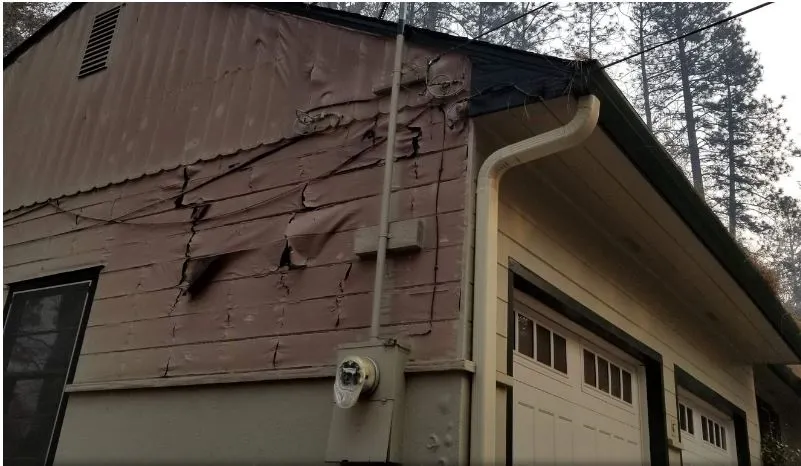
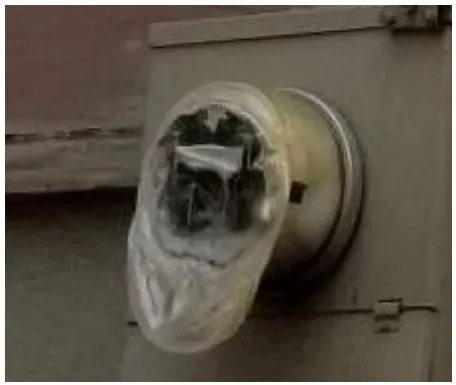
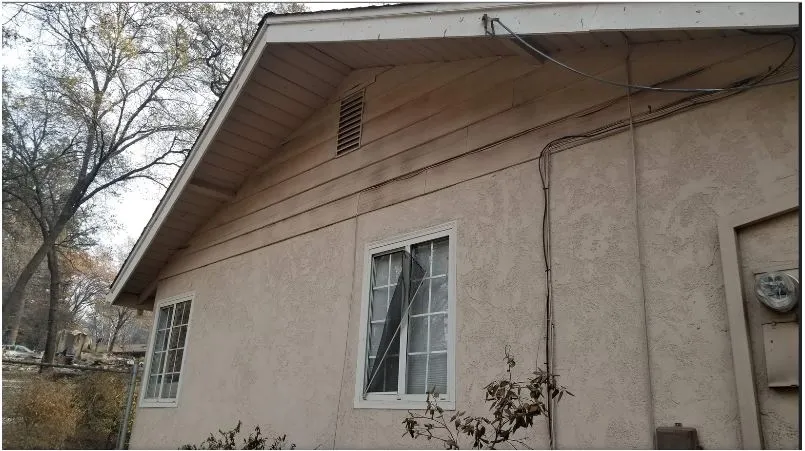

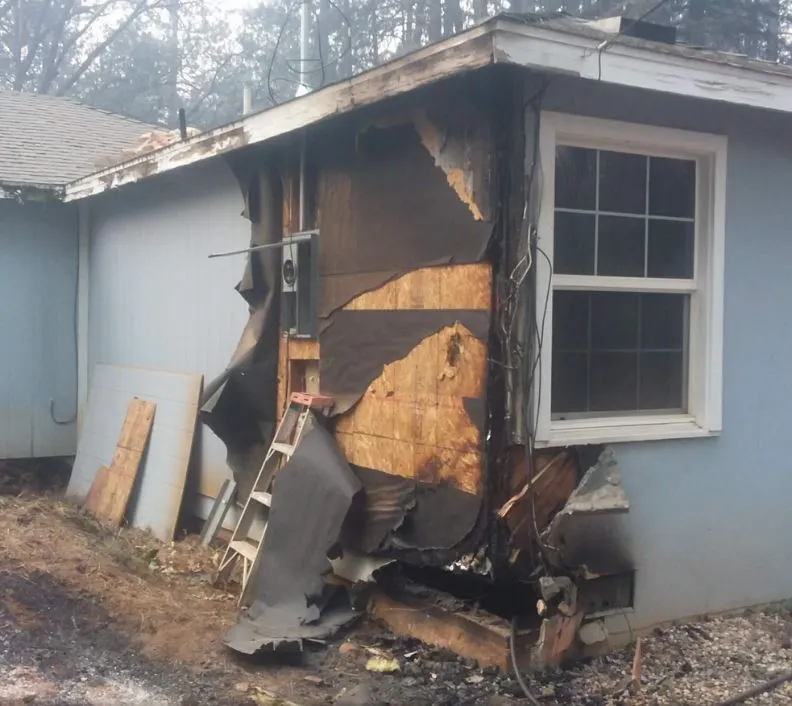


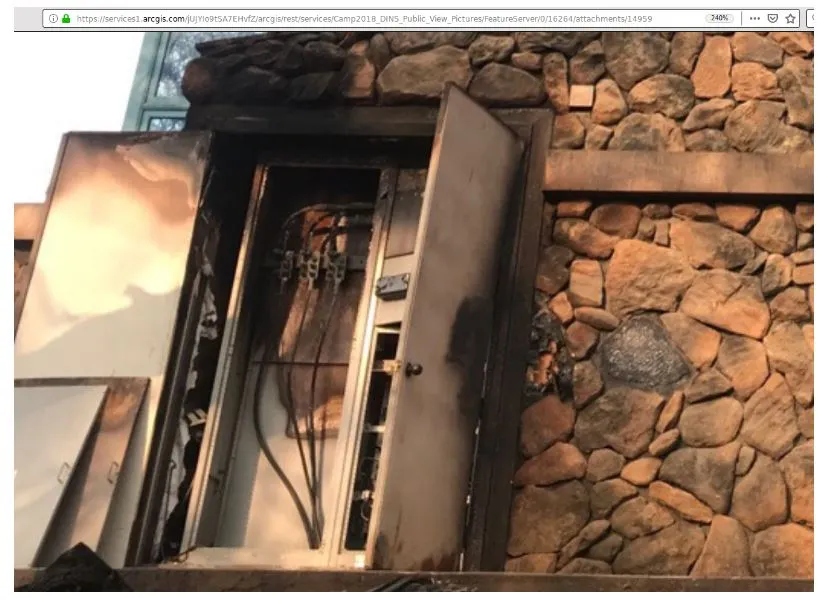
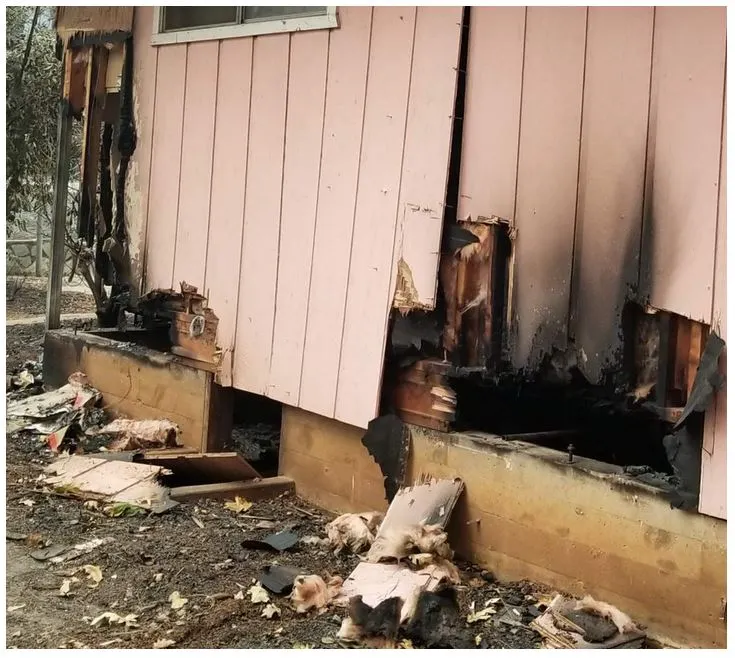

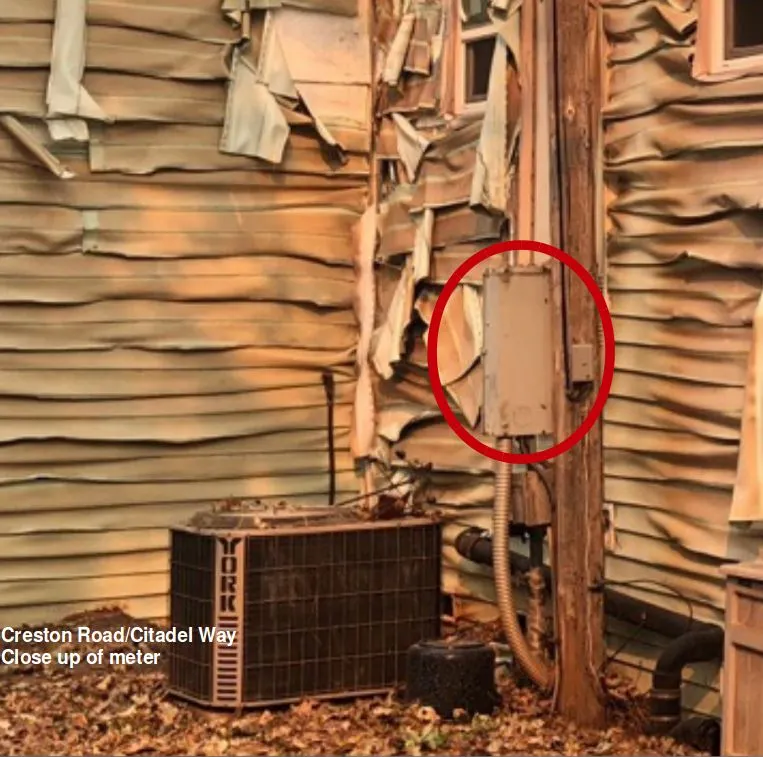
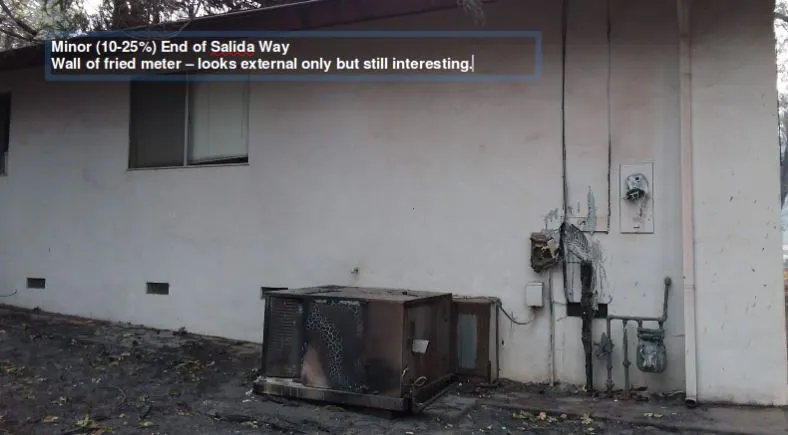
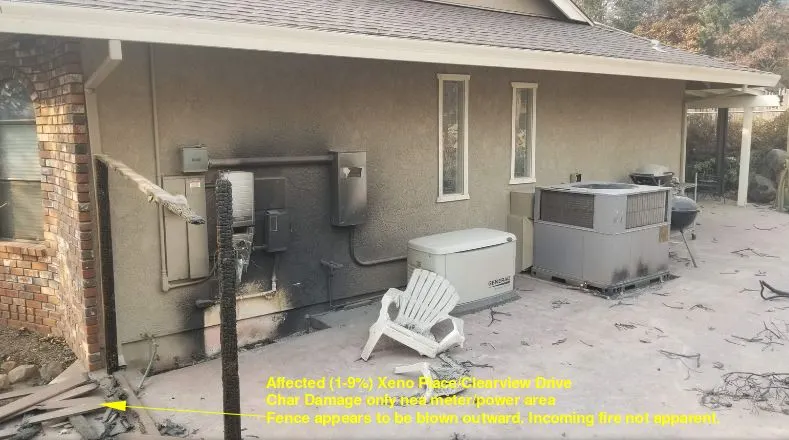
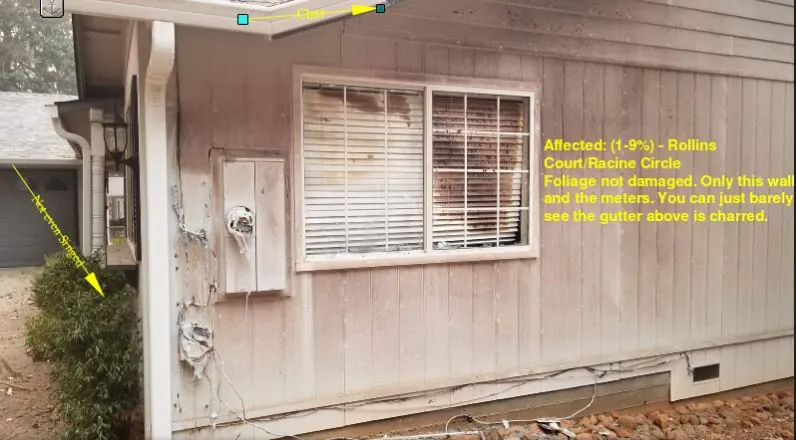

She writes, “Attached are 7 more properties with smart meter and other anomalies. If you want to check out the pictures yourself, and type in the name of the street at the left top of the screen. I believe I got the cross streets close enough where you will also be able to view the properties as well.”
“I am also studying some of the (>50%) destroyed homes/structures, and besides the fact that they ARE DISINTEGRATED, I’ve also noticed that many propane tanks remain intact. Among other strange remaining things. I’ll be doing some research on that at well. Hopefully I can do this before the rain is done and they take the site down.”
A journey election said: Is it the smart meter or could it be an induced surge into the electrical supplying these dwellings? As a 40 year experienced electrician these pictures look to me much the same as lightning strikes that I have repaired in the past. Could the D.E.W. be inducing these high voltages into the infrastructure. Only a extreme surge would fry the insulation off of the wiring and melt these meters.
Maui fire victims reported numerous and continuous explosions and structures ‘exploding’ in flames. Old buildings that install smart meters are at significant risk to power surges without total replacement of old wiring in the structure >> that is Lahaina. Very old buildings, old wiring.
All smart meters are on the Cloud and can be remotely controlled and hacked. A brush fire does not guarantee total destruction of structures, smart meters do. Basically one chance to get it right, if the goal is complete destruction and chasing off and/or liquidating the inhabitants. Light the fuse of a brush fire and ignite the smart meters and turn off the water. Blame downed powerlines and incompetence.
source
https://en.wikipedia.org/wiki/Smart_meter
https://yandex.com/video/preview/14282957215784196402
